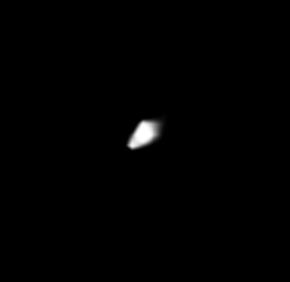Mab (moon)
Moon of Uranus From Wikipedia, the free encyclopedia
Moon of Uranus From Wikipedia, the free encyclopedia
Mab, or Uranus XXVI,[7] is an inner satellite of Uranus. It was discovered by Mark R. Showalter and Jack J. Lissauer in 2003 using the Hubble Space Telescope.[8] It was named after Queen Mab, a fairy queen from English folklore who is mentioned in William Shakespeare's play Romeo and Juliet.[7]
 | |
| Discovery | |
|---|---|
| Discovered by | Mark R. Showalter and Jack J. Lissauer |
| Discovery date | August 25, 2003 |
| Designations | |
Designation | Uranus XXVI |
| Pronunciation | /ˈmæb/[1] |
| Adjectives | Mabian[2] |
| Orbital characteristics[3] | |
| 97 736 km | |
| Eccentricity | 0.00347 |
| 0.923 d | |
Average orbital speed | 7.70 km/s (calculated) |
| Inclination | 0.12217° (to Uranus' equator) |
| Satellite of | Uranus |
| Physical characteristics | |
| 6 km/12.4±0.5 km | |
| ~450/1930 km2 | |
| Volume | ~900/7990 km3 |
| Mass | ~(0.90/8.0)×1015 kg |
Mean density | 0.5–1.2 g/cm3[4] 1 g/cm3 (assumed) |
| ~0.002/0.003 m/s2 | |
| ~0.004/0.009 km/s | |
| synchronous | |
| 0 | |
| Albedo | ~0.46/0.1 (assumed)[5] |
| Temperature | ~63 K |
| 26[6] | |
Because the moon is small and dark, it was not seen in the heavily scrutinized images taken by Voyager 2 during its Uranus flyby in 1986. However, it is brighter than another moon, Perdita, which was discovered from Voyager's photos in 1997. This led scientists to re-examine the old photos again, and the satellite was finally found in the images.[9] Following its discovery, Mab was given the temporary designation S/2003 U 1.[8]
The size of Mab is not precisely known. If it is as dark as Puck, it is about 24.8±1.0 km in diameter.[11] On the other hand, if it has a relatively bright surface like the neighbouring moon Miranda, it would be smaller than Cupid and comparable to the smallest outer satellites.[9] Infrared observation published in 2023 suggest that Mab is probably a 12-km body with a Miranda-like surface, rich in water ice; though not leaving out the possibility of it being a 24-km body with a Puck-like surface.[5]
Mab is heavily perturbed. The actual source for perturbation is still unclear, but is presumed to be one or more of the nearby orbiting moons.[9]
Mab orbits at the same distance from Uranus as the μ ring (formerly known as R/2003 U 1), a dusty ring discovered around the same time as Mab. The moon is nearly the optimal size for dust production, since larger moons can recollect the escaping dust and smaller moons have too small surface areas for supplying the ring via ring particle or meteoroid collisions.[12] No rings associated with Perdita and Cupid have been found, probably because Belinda limits the lifetimes of dust they generate.[9]
Seamless Wikipedia browsing. On steroids.
Every time you click a link to Wikipedia, Wiktionary or Wikiquote in your browser's search results, it will show the modern Wikiwand interface.
Wikiwand extension is a five stars, simple, with minimum permission required to keep your browsing private, safe and transparent.